
Publications
Publishing is integral to IFAR's mission as an educational organization. Our publications have documented global events in art theft and art fraud and have played a critical role in IFAR's own research in authentication, connoisseurship and other scholarship on art objects.
Art thefts in the 1970s prompted IFAR’s first publications: two books on art theft and a monthly newsletter on theft and looting (Art Theft Archive, 1979; later renamed Stolen Art Alert). Simultaneously, IFAR published a quarterly featuring its own research (Art Research News, 1980-1984). In 1984, Art Research News merged with the by-then-invaluable Stolen Art Alert, and became IFARreports (1985-1998), published ten times a year.

IFAR Journal
In 1998, the more substantive, award-winning quarterly IFAR Journal replaced IFARreports. While the popular Stolen Art Alert continued inside each issue of the Journal, IFAR's new Website and Journal signified a shift in focus away from stolen art registration and searches to emphasize education and research regarding the ethical, legal and scholarly issues concerning art objects. In addition to news stories and book reviews, the Journal contains feature articles on art authenticity and attribution; forgery and fraud; art law and ethics; World War II-era art restitution issues; conserving, restoring and caring for art; and art theft.
In 1998, the more substantive, award-winning quarterly IFAR Journal replaced IFARreports. While the popular Stolen Art Alert continued inside each issue of the Journal, IFAR's new Website and Journal signified a shift in focus away from stolen art registration and searches to emphasize education and research regarding the ethical, legal and scholarly issues concerning art objects. In addition to news stories and book reviews, the Journal contains feature articles on art authenticity and attribution; forgery and fraud; art law and ethics; World War II-era art restitution issues; conserving, restoring and caring for art; and art theft.
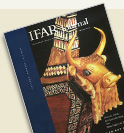
IFAR Journal: Special Issues
Periodically, IFAR devotes an entire Journal or part of a special double issue to an important topic in the news. Both the 9/11 attack on the World Trade Center in 2001, and the U.S. invasion of Iraq in 2003, involved the destruction and disappearance of art works. IFAR responded with two double issues of the IFAR Journal. The first included the edited proceedings from IFAR’s symposium, September 11th: Art Loss, Damage and Repercussions. The eight articles were also published online. The other, "Art Loss in Iraq," was published in 2003 and five articles were also placed online. IFAR will continue this tradition of publishing double issues for significant, topical issues.
Periodically, IFAR devotes an entire Journal or part of a special double issue to an important topic in the news. Both the 9/11 attack on the World Trade Center in 2001, and the U.S. invasion of Iraq in 2003, involved the destruction and disappearance of art works. IFAR responded with two double issues of the IFAR Journal. The first included the edited proceedings from IFAR’s symposium, September 11th: Art Loss, Damage and Repercussions. The eight articles were also published online. The other, "Art Loss in Iraq," was published in 2003 and five articles were also placed online. IFAR will continue this tradition of publishing double issues for significant, topical issues.
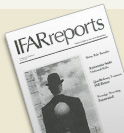
IFARreports
Published ten times a year from 1985 until 1998, IFARreports included Stolen Art Alert and the authentication research found in Art Research News. Bestselling issues included articles on the Isabella Stewart Gardner Museum theft in 1990, the Salvador Dalí print forgeries scandal and the role of the Center Art Galleries, on which IFAR reported from 1982 through 1994; and coverage of repatriation stories such as Turkey's efforts to recover the "Lydian Hoard" from The Metropolitan Museum of Art and Germany’s efforts to reclaim the Quedlinburg Treasure looted by an American soldier just after World War II.
Published ten times a year from 1985 until 1998, IFARreports included Stolen Art Alert and the authentication research found in Art Research News. Bestselling issues included articles on the Isabella Stewart Gardner Museum theft in 1990, the Salvador Dalí print forgeries scandal and the role of the Center Art Galleries, on which IFAR reported from 1982 through 1994; and coverage of repatriation stories such as Turkey's efforts to recover the "Lydian Hoard" from The Metropolitan Museum of Art and Germany’s efforts to reclaim the Quedlinburg Treasure looted by an American soldier just after World War II.
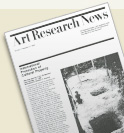
Art Research News
IFAR devoted the quarterly, Art Research News, to its own authentication and other research from 1980 through 1984. Among stories that IFAR brought to light were the examination and discovery of seven Thomas Hart Benton forgeries, which originated from various sources in Kansas City and New York, and eighteen modern master forgeries, many with gallery labels (some fake), that originated in the Joseph Hartert Collection.
IFAR devoted the quarterly, Art Research News, to its own authentication and other research from 1980 through 1984. Among stories that IFAR brought to light were the examination and discovery of seven Thomas Hart Benton forgeries, which originated from various sources in Kansas City and New York, and eighteen modern master forgeries, many with gallery labels (some fake), that originated in the Joseph Hartert Collection.
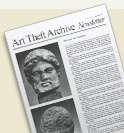
Art Theft Archive Newsletter
A brief precursor to the Stolen Art Alert, the Art Theft Archive Newsletter (ten issues, published only in 1979) reported on thefts, recoveries, World War II looting issues, and criminal convictions of art fraud perpetrators. It also discussed security measures for art collections, and covered the debate over U.S. ratification of the 1970 UNESCO Convention.
A brief precursor to the Stolen Art Alert, the Art Theft Archive Newsletter (ten issues, published only in 1979) reported on thefts, recoveries, World War II looting issues, and criminal convictions of art fraud perpetrators. It also discussed security measures for art collections, and covered the debate over U.S. ratification of the 1970 UNESCO Convention.
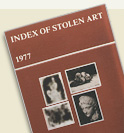
Books
IFAR's first publications were two books on stolen art: an index of its Art Theft Archive and an in-depth analysis of art theft statistics.
IFAR's first publications were two books on stolen art: an index of its Art Theft Archive and an in-depth analysis of art theft statistics.
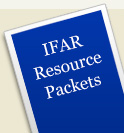
Resource Packets
In addition to its periodicals, IFAR has published and distributed the results of its own original research as well as that of others in the field. For its groundbreaking conferences on Provenance and Due Diligence and on Catalogues Raisonnés, it compiled many of the key materials into resource packets that were distributed at the conferences and that are still available for purchase.
In addition to its periodicals, IFAR has published and distributed the results of its own original research as well as that of others in the field. For its groundbreaking conferences on Provenance and Due Diligence and on Catalogues Raisonnés, it compiled many of the key materials into resource packets that were distributed at the conferences and that are still available for purchase.
